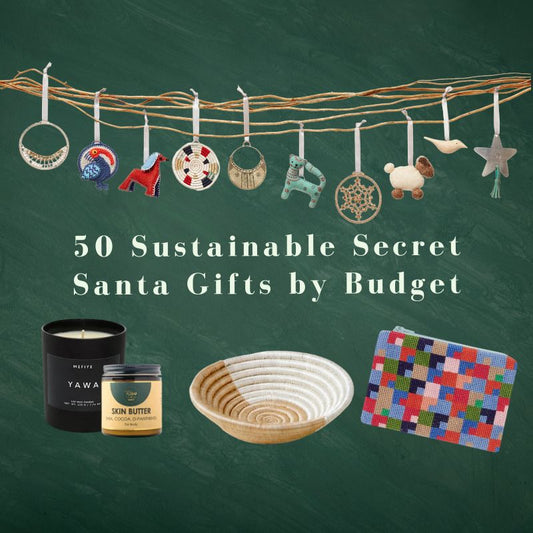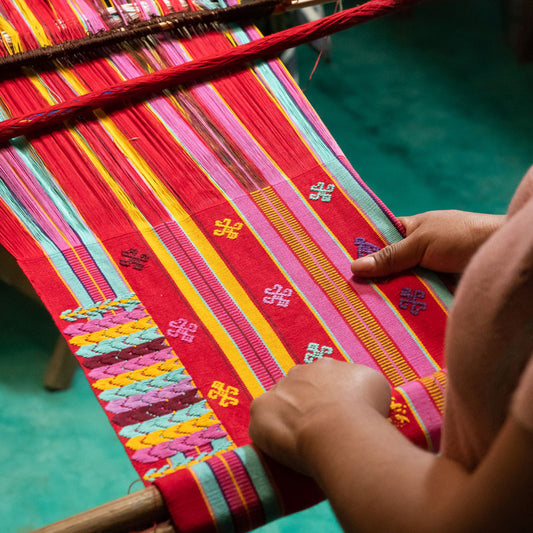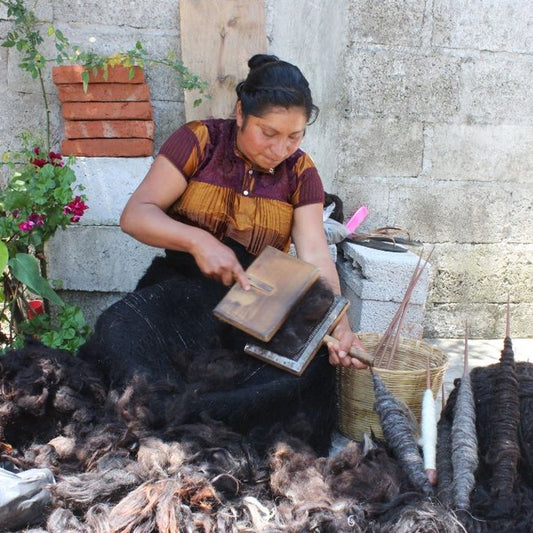22 simple ways to be more sustainable in the new year
As 2021 draws to an end you may find yourself looking to the new year and thinking about the positive changes you want to make. For many of us – with the COP26 climate change talks still ringing in our ears – we’re giving thought to how to live more sustainably in 2022.
With a tsunami of information and tips available on becoming more sustainable, it can be overwhelming knowing where to begin. One way to go forward is to start small. Break up the task by looking at different areas in your life where you think you can improve and then set yourself achievable goals.
To get you started, we’ve put together a list of steps that anyone can take toward achieving a greener future. Whilst reducing single-use plastic and switching to energy-saving lightbulbs are of course important, this article focuses more on those areas we know best. Styling your home with the planet in mind, for example. Or how to find meaningful gifts that don’t cost the earth. And as we are entering 2022, it only seemed appropriate to do 22.
So here it is. 22 small but significant changes to help you live more sustainably in 2022.
How to make your home more sustainable
Greening your interiors shouldn’t have to mean compromising on style or luxury. The key is to take a slow, mindful approach and really think about what works for you and your home. Get started with these 5 simple tips on how to be more sustainable at home.
1. Choose natural fibres
When sourcing furniture and textiles for your home, choose those made from natural materials such as jute, wood, wool or even cactus silk. This helps to cut down on the production of synthetic materials that ultimately end up in landfills and ensures the materials are free of toxic chemicals.
2. Know the company’s ethics
Look for companies that are being responsible and transparent about their social and environmental impact. Try to prioritise those committed to fair trade principles to ensure that fair labour practices – including fair wages and good working conditions – are sustained throughout the supply chain. Trusted certifications can help you to find companies that are minimising their impact. See here for a list of green labels you can trust.
3. Decorate with longevity in mind
Forget trends. Just like fast fashion, trends are short-lived, wasteful and lacking in originality. Instead, opt for meaningful items that celebrate self-expression. “It should be a reflection of you, your passions, your interests, and it should be a celebration of you and your family,” Kemi Lawson, founder of The Cornrow, tells AKOJO in our community series, Meaningful Spaces.
4. Fill your home with indoor plants
Green your indoors in the literal sense by filling your home with indoor plants. Not only do houseplants look great, but they can also help to reduce stress, boost mental health and improve air quality. Just be mindful of where you source your green friends from to keep those “plant miles” down.
Looking for eco-friendly plant pots? See our selection of natural jute planters here.
5. Use eco-friendly cleaning products
Many cleaning products contain chemicals that are harmful to the environment. Keep a critical eye on the ingredients and opt for natural, non-toxic cleaning products that are made using sustainable manufacturing practices.
How to make your beauty regime more sustainable in the new year
When it comes to environmental impact, the beauty industry has a pretty bad rep. Especially when it comes to waste and pollution. The good news is there are lots of brands taking steps to be more ethical, transparent, and environmentally safe. Green up your beauty regime with these eco-friendly tips.
1. Think about packaging
With endless virgin plastic, lavish cellophane wrappers and countless cardboard boxes, it’s no secret the beauty industry has a packaging problem. Look for brands using minimal packaging, minimal plastic and recyclable materials. Bar soaps – such as RAW Beauty’s natural skin soaps– are an easy switch that not only need less packaging but also much less water to produce.
2. Choose natural ingredients
Beauty products with natural and organic ingredients are not only good for your skin but good for the environment as well. The key here is to read labels. We know beauty labels can be a little daunting so look for those using natural and minimal ingredients and identify brands you know you can trust.
3. Ditch the disposables
Swap single-use makeup wipes, razors and other bathroom accessories for reusable alternatives made from sustainable materials. Start by saying goodbye to single-use cotton pads. Reusable cotton pads will not only prevent hundreds from ending up in landfills each year, but it will also reduce water and pesticide consumption by requiring less cotton to be grown. They also look great stored in glass jars, such as these beautiful storage jars by Qasa Qasa.
How to dress more sustainably in the new year
The fashion industry is one of the main polluting industries, accounting for around 8-10% of global emissions. But your wardrobe doesn’t have to cost the earth. Dress for the future and reduce your impact on the climate with these 7 simple tips.
1. Buy less, buy better
Investing in a few high-quality items a year rather than lots of cheaper, less eco-friendly pieces will dramatically reduce your carbon footprint. Whilst these items may initially be more expensive, you’re likely to have them for longer meaning you’ll spend less in the long run. So choose wisely and make each purchase count!
2. Support brands that are ethical and sustainable
Fashion doesn’t have to be fast. There are many wonderful brands that create clothing in a way that considers the wider environment and community. Like those on our platform, for instance, who use ancient craft and traditional techniques to create timeless, high-quality garments.
Note: More and more brands are starting to flaunt their sustainability “credentials”, but sadly not all of these claims are backed up by facts. Do your research and keep a look out for greenwashing with these top tips.
3. Choose materials wisely
Some materials are better for the planet than others so it can be helpful to know your fabrics. Look for natural fibres like linen, hemp and silk. Whilst conventional cotton can be problematic, GOTS-certified organic cotton is a sustainable option, or better yet, recycled cotton. With jewellery, look for brands using recycled materials like these handcrafted earrings from Meraki Jewellery made using repurposed brass.
4. Repair, repair, repair
Stop clothes entering landfills by learning how to mend your clothes or sew on a new button. Picking up the thread or learning how to remove stains can make your clothes last longer, minimising your impact on the environment and saving you money.
5. Question yourself before you buy
Eliminate impulse buying with questions like: how often will you wear it? Will it fit in your wardrobe? Do you really need it? We love the 30 wears rule by Livia Firth, founder of sustainability consultancy Eco-Age: “Will I wear it at least 30 times?”
6. Wear more, wash less
How you wash, dry and care for your clothes all have an impact. Try to reduce how often you wash your clothes, use cold water where possible, and always run full loads. If you can, hang your laundry up to air dry, especially in the warmer months.
7. Consider made to order
Making clothes on a made-to-order basis is a more ethical and sustainable approach to fashion that is growing in popularity. It reduces waste and unwanted stock (that will ultimately end in landfill) by only making exactly what is needed when it’s needed.
How to be a more sustainable parent or guardian
When it comes to styling your nursery or dressing your baby, choices that are kinder to the planet are often naturally kinder to your kids too. Where possible, look for organic, natural materials that are low in environmental toxins and help create a greener world for the generations to come.
1. Build a long-lasting wardrobe
Whilst kid’s go through a lot of clothes, it’s important not to sacrifice on quality. Long-lasting, durable materials are more likely to survive playtime, wash well, and have the potential to be passed on to future siblings. Try to avoid synthetic materials and dyes and instead choose eco-friendly fibres such as organic cotton that are better for the planet and your baby.
2. Buy toys that don’t cost the earth
Toys made from natural fibres have much less impact on the environment compared to plastic toys. They’re also much less likely to contain chemicals that are harmful to your child. Wood is a great choices, like these gorgeous handwoven baby rattles made from cane.
3. Create an eco-friendly nursery
Like with clothes and toys, it’s important to consider what you put into your nursery. Again look for natural, non-toxic materials – like cane, willow or grass – and buy with longevity in mind. When your child outgrows its nursery, store your Moses basket and other nursery room essentials away for potential siblings and grandchildren, or pass them onto a friend as they build their sustainable nursery.
How to gift more sustainably
As much as we all love it, it’s fair to say that gifting can be a little wasteful. Single-use plastic packaging. Endless rolls of wrapping paper. Unwanted presents thrown in the bin. But it doesn’t have to be that way. Gift a little more meaningfully next year with these 3 sustainable gifting tips.
1. Avoid last-minute panic buying by planning ahead
Now we know that is a lot easier said than done but we have a simple trick up our sleeve: having a selection of thoughtful gifts at home so that you’re always prepared! One way to do this is with our range of curated ethical gift boxes. Filled with unique artisan-made gifts, keep the box at home as a storeroom of artisan-made presents to gift at your pleasure. And once done, you can even reuse the box as a sustainable packaging option.
2. Look for ethically produced and fair trade gifts
Feel good in your choice by choosing brands rooted in ethical and fair labour practices, such as safe working conditions, fair pay and the preservation of local craft. By buying fair trade, you’re helping to support talented artisans across the world and are also much more likely to find something unique. Find the perfect ethical gift for any occasion in our range of curated gift guides.
3. Choose recycled jewellery
Jewellery is a classic gift and for good reason. But sadly mining for raw materials has a cost on the planet. The good news is, there are plenty of metals and other materials in circulation that can be recycled into jewellery that looks as good as new. Take Lala Salama, for example, who use recycled brass throughout their collection.
4. Opt for a gift card
A gift card is the ultimate gift for those difficult-to-buy people. And by letting your recipient choose exactly what they receive, you’re guaranteed to give a gift that is wanted, not wasted. Why not choose a gift card from us? You choose the amount, and we’ll do the rest.
We hope this list has given you some ideas on how to live a more environmentally sustainable lifestyle in the new year. If you have any more tips on how to be sustainable, share them with us by tagging us on @akojomarket.













